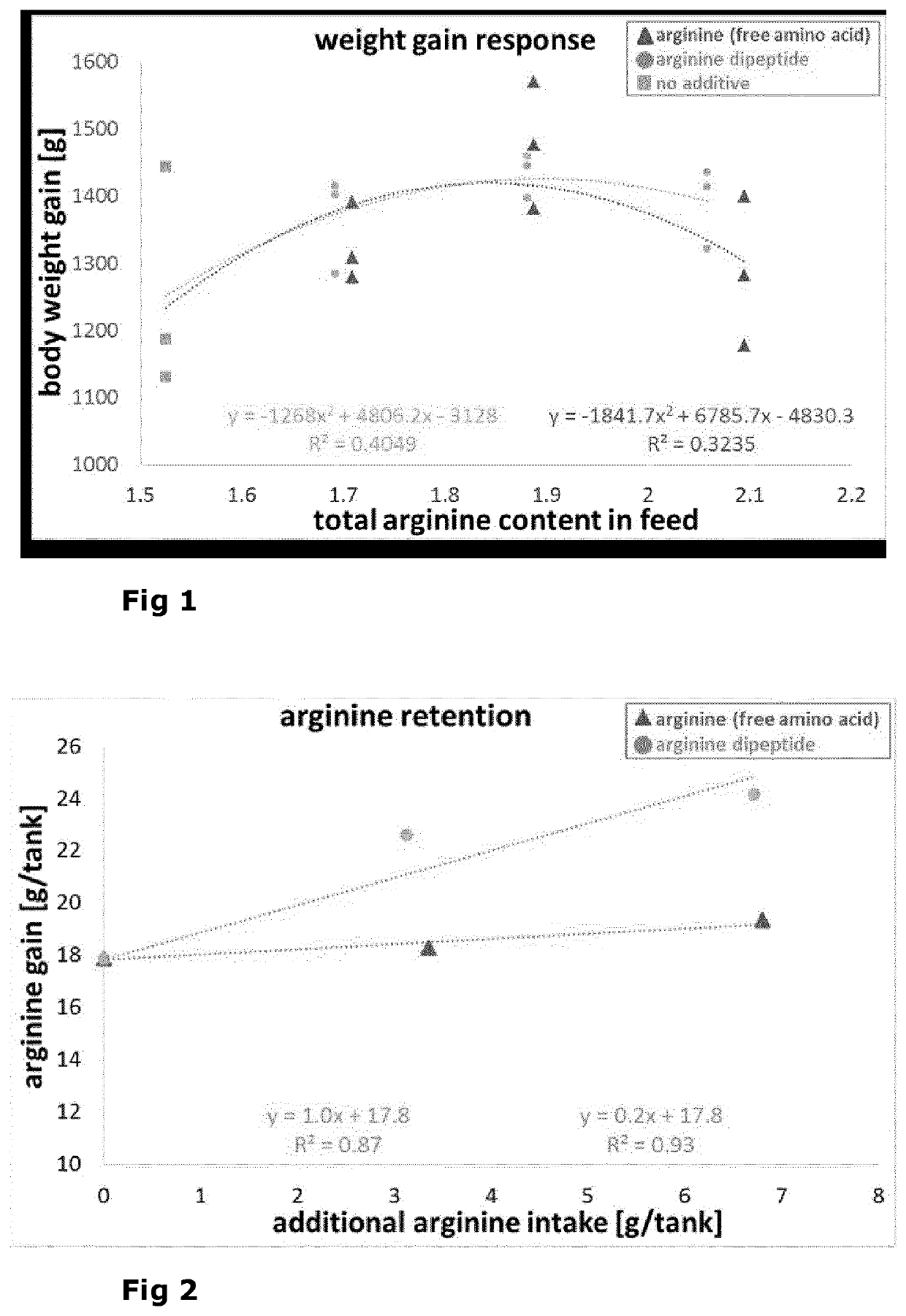Method for culturing aquatic animals with aspartyl-dipeptides
a technology of aspartyldipeptides and aquatic animals, which is applied in the field of culturing aquatic animals with aspartyldipeptides, can solve the problems of unselective method and thereby product, difficult scaling up, and high cost, and achieves the effects of reducing the number of animals, and increasing the number of animals
- Summary
- Abstract
- Description
- Claims
- Application Information
AI Technical Summary
Benefits of technology
Problems solved by technology
Method used
Image
Examples
example 1
n of Dipeptide Composition
[0046]CGP and the extracellular CGPase enzyme were produced via separate fermentations before the final CGPase-catalysed breakdown of CGP into dipeptides took place. A recombinant strain of Ralstonia eutropha H16-PHB−4-Δeda (pBBR1MCS-2::cphA6308 / edaH16) was used for the production of CGP in a 500 L fermentation and using Na-gluconate as a sole carbon source, while the CGPase was produced with P. alcaligenes strain DIP1 CphEal, said strain having been deposited with the DSMZ as DSM 21533. CGP was then extracted from the produced biomass and purified. CGPase enzyme was purified from the culture supernatant. The produced CGP and the CGPase were then combined under specific conditions, upon which the biopolymer was broken down into its constituent dipeptides. The β-aspartyl-arginine dipeptides were then separated from the remainder of the reaction, analyzed for purity via HPLC, and finally dried to a powder (WO2009150252 and Sallam et al., AEM 75:29-38(2009)). ...
example 2
re Screening Experiments
[0047]Nearly all of the finfish species relevant to aquaculture belong to three supra-orders: Ostariophysi (e.g. carps, catfish, and allies), Protacanthopterygii (e.g. pike, trouts and salmon), and Acanthopterygii (around 50% of all fish species, including all perches, flatfish, tuna, etc.). In order to cover as much of the phylogenetic range as possible, fish species were chosen from each of these supra-orders (Ostariophysi; Clarias gariepinus, Protacanthopterygii; Oncorhychus mykiss, Acanthopterygii; Oreochromis niloticus). Additionally, kuruma shrimp (Marsupenaeus japonicus) was chosen as a representative species of crustacean due to its significance in the high-end market. At the end of the experiment, the individual weights were recorded and the data analyzed statistically. All experiments started with young fry or postlarvae.
[0048]All species except trout were housed during the experiments in parallel recirculation systems of fresh water. Marsupenaeus j...
example 3
tyl Dipeptides for Salmon Nutrition
[0063]The objective of the experiment was to examine the in vivo bioavailability of the above described “β-L-aspartyl-R” dipeptides in fish for the first time and consequently to determine their applicability as a substitute of free amino acids sources in Atlantic salmon (Salmo salar L.) nutrition. Therefore, varying supplementation levels of β-L-aspartyl-L-arginine in contrast to a mixture of free amino acids L-arginine and L-aspartic acid were compared.
[0064]315 Atlantic salmon (96.33 g±11.47 g; Danish Salmon AS, Hirtshals, DK) were acclimatized for 14 d in the experimental rearing system. The tanks of the system were part of a recirculation system (3.5 m3 water volume, turnover rate 2 h−1). The water purification system consisted of a mechanical filter, a moving bed filter, and a protein skimmer. Water quality parameters were maintained within a safe range for the fish (7.2-7.6 pH; GMH 3530, Digital pH- / mV- / Thermometer, Greisinger electronic, D;...
PUM
 Login to View More
Login to View More Abstract
Description
Claims
Application Information
 Login to View More
Login to View More - R&D
- Intellectual Property
- Life Sciences
- Materials
- Tech Scout
- Unparalleled Data Quality
- Higher Quality Content
- 60% Fewer Hallucinations
Browse by: Latest US Patents, China's latest patents, Technical Efficacy Thesaurus, Application Domain, Technology Topic, Popular Technical Reports.
© 2025 PatSnap. All rights reserved.Legal|Privacy policy|Modern Slavery Act Transparency Statement|Sitemap|About US| Contact US: help@patsnap.com

